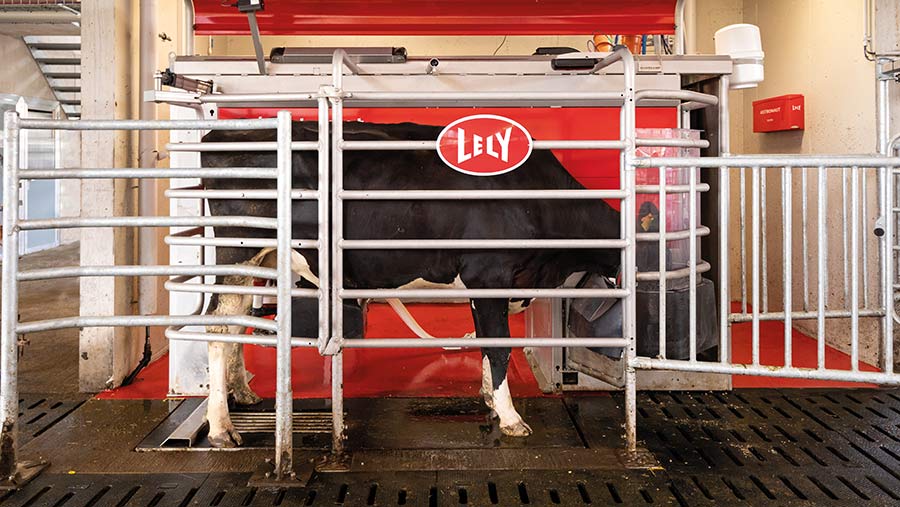6 ways to improve udder health in automatic milking systems
 © Lely
© Lely There are numerous advantages associated with robotic milking, but it also comes with challenges.
Although automatic milking systems (AMS) rarely have incorrect milking settings – which can be a big win in helping to reduce mastitis – problems with accurate teat detection means hygiene can be more difficult to control among failed milkings.
See also: 6 steps to optimise milking machine settings for your herd
Tom Greenham, a director with Advance Milking, explains some of the key AMS risk factors and how to overcome them.
Teat Hygiene
Pre-milking teat cleaning with AMS has some key limitations. Brushing tends to give a better visual clean if the teats are heavily soiled, but is vulnerable to inaccurate location of the teat.
Height settings can lead to the transfer of dirt from the udder skin to the teat.
Cup cleaning can give better disinfection, provided soiling is not too heavy, but is vulnerable to inaccurate attachment or kick-offs.
Sensor technology to allow a response to dirtier teats is not yet fully developed, so environmental management is crucial to minimise teat contamination.
Post-milking disinfection can also be ineffective in AMS. Spray accuracy is often poor. This requires fine-tuning of spray arm positioning and volume and duration of spraying to achieve adequate skin coverage.
Dipping gives more reliable teat coverage but is ineffective if kick-offs are common.
Environmental challenge
Building design and management have an even bigger influence on udder health in AMS than in conventional herds.
Slurry management is performed with cows in the building, so requires either automated systems or slatted floors.
High attention to detail and innovative approaches are needed to maintain environmental hygiene. Manual slurry management is required in areas inaccessible to automated systems.
Foot-baths at the box exit risk contamination of the teat before full closure of the sphincter, but siting on entry to the box tends to reduce visits.
Guided traffic systems may have more options for foot-bathing but, with variable cow traffic through the bath, maintaining appropriate frequencies of foot-bath replenishment is a challenge for all systems.
Machine hygiene
In AMS more cows are milked through the same milking liners than is common in conventional milking.
This increases potential contamination with contagious pathogens such as Staphylococcus aureus, giving much higher transmission risk.
Different AMS models feature various options for disinfecting equipment between cows.
Unfortunately, at the levels of contamination commonly seen, these strategies rarely reduce bacterial challenge to non-infectious levels.
This makes early detection of contagious bacteria vital, with proactive interventions to reduce the spread before prevalence rises
Milking conditions
AMS technologies generally give a gentle milking with low levels of machine risk factors for mastitis.
Vacuum and pulsation settings are well established for the various box models, with incorrect settings rarely seen.
Consistent preparation protocols give good milk let-down and quarter-level milking helps reduce the duration of overmilking.
Silicon liners are commonly used, reducing the risk of teat-end hyperkeratosis.
The only significant issue with AMS is the increased chance of a failed milking at the udder or quarter level.
Missed milkings increase discomfort, risk cows leaking milk, and have been associated with increased clinical mastitis.
Milking frequency and interval
Cows in AMS tend to have a higher milking frequency, particularly at higher milk yields.
Different studies show contradictory results as to whether this has a positive or negative effect on udder health.
Whether higher frequency increases or decreases mastitis risk depends on whether the benefits of increased milking frequency outweigh potential negative consequences.
The positives being, improved teat hygiene, lower intra-mammary pressure and reduced opportunity for bacterial colonisation.
The negatives, more periods with an open teat end, increased exposure to contaminated milking apparatus and greater exposure to trauma of the teat tissues.
Spread of milkings throughout the day is also important, with some data suggesting irregular gaps between milkings increase infection risk.
Effects of other diseases
Transition diseases have a bigger impact in AMS than conventional herds, due to altered visit frequency and interval.
Lame cows have fewer visits and longer queueing times to enter the box.
Longer, less consistent milking intervals may predispose mastitis and greater time spent queueing increases the risk of contamination of the udder and teats.
Lame cows also feed less frequently (particularly in guided traffic systems), altering metabolic status and rumen health to give indirect increases in mastitis risk.
Trace element imbalances may occur if concentrate feeding in the AMS box is used to encourage visits, as is common in free-access systems.
Some minerals are unpalatable and are therefore excluded in case they deter cows from visiting the robot.
Deficiency in minerals such as selenium can increase the incidence and severity of clinical mastitis.
Key priorities for udder health in AMS
Good udder health in AMS can readily be achieved by mitigating the additional risk factors:
Maximise cow cleanliness:
- Focus on passage cleanliness and cubicle hygiene
- Refine the foot-bathing strategy to ensure no more than 100 cow passes before cleaning the bath and replenishing the solution
- Fetch infrequent milkers for foot-bathing.
Optimise pre-milking disinfection:
- Use double teat-preparation protocols to improve milk flow rates and balance the extra time taken
- Refine location and positioning settings.
Minimise unsuccessful milkings:
- Singe udder hair and trim tails
- Do daily maintenance checks on positioning cameras/lasers
- Alter visit permissions for cows with failed milkings to allow them to return to the robot earlier to be milked.
Monitor for contagious pathogens:
- Carry out monthly surveillance testing for contagious bacteria with your vet
- Seek expert advice if Staphylococcus aureus detected – this is an AMS emergency
- Eliminate lameness (target less than 2% prevalence) and focus on optimising transition health.

